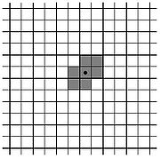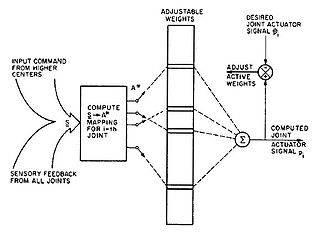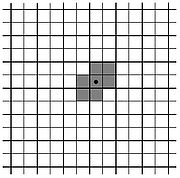
Cerebellar Model Articulation Controller
Encyclopedia

Cerebellum
The cerebellum is a region of the brain that plays an important role in motor control. It may also be involved in some cognitive functions such as attention and language, and in regulating fear and pleasure responses, but its movement-related functions are the most solidly established...
. It is also known as the Cerebellar Model Arithmetic Computer. It is a type of associative memory
Associative memory
Associative memory may refer to:* A type of memory closely associated with neural networks.* A recent technology that involves creating a memory of multiple databases, both structured and unstructured data, and making associations in a manner that is similar to the human brain's memory functions.**...
.
Overview
The CMAC was first proposed as a function modeler for robotic controllers by James Albus in 1975 (hence the name), but has been extensively used in reinforcement learningReinforcement learning
Inspired by behaviorist psychology, reinforcement learning is an area of machine learning in computer science, concerned with how an agent ought to take actions in an environment so as to maximize some notion of cumulative reward...
and also as for automated classification in the machine learning
Machine learning
Machine learning, a branch of artificial intelligence, is a scientific discipline concerned with the design and development of algorithms that allow computers to evolve behaviors based on empirical data, such as from sensor data or databases...
community. CMAC computes a function
 , where
, where  is the number of input dimensions. The input space is divided up into hyper-rectangles, each of which is associated with a memory cell. The contents of the memory cells are the weights, which are adjusted during training. Usually, more than one quantisation of input space is used, so that any point in input space is associated with a number of hyper-rectangles, and therefore with a number of memory cells. The output of a CMAC is the algebraic sum of the weights in all the memory cells activated by the input point.
is the number of input dimensions. The input space is divided up into hyper-rectangles, each of which is associated with a memory cell. The contents of the memory cells are the weights, which are adjusted during training. Usually, more than one quantisation of input space is used, so that any point in input space is associated with a number of hyper-rectangles, and therefore with a number of memory cells. The output of a CMAC is the algebraic sum of the weights in all the memory cells activated by the input point.A change of value of the input point results in a change in the set of activated hyper-rectangles, and therefore a change in the set of memory cells participating in the CMAC output. The CMAC output is therefore stored in a distributed fashion, such that the output corresponding to any point in input space is derived from the value stored in a number of memory cells (hence the name associative memory). This provides generalisation.
Building blocks

The CMAC is trained by presenting pairs of input points and output values, and adjusting the weights in the activated cells by a proportion of the error observed at the output. This simple training algorithm has a proof of convergence.
It is normal to add a kernel function to the hyper-rectangle, so that points falling towards the edge of a hyper-rectangle have a smaller activation than those falling near the centre.
One of the major problems cited in practical use of CMAC is the memory size required, which is directly related to the number of cells used. This is usually ameriolated by using a hash function
Hash function
A hash function is any algorithm or subroutine that maps large data sets to smaller data sets, called keys. For example, a single integer can serve as an index to an array...
, and only providing memory storage for the actual cells that are activated by inputs.
Further reading
- Albus, J.S. (1971). "Theory of Cerebellar Function". In: Mathematical Biosciences, Volume 10, Numbers 1/2, February 1971, pgs. 25-61
- Albus, J.S. (1975). "New Approach to Manipulator Control: The Cerebellar Model Articulation Controller (CMAC)". In: Transactions of the ASME Journal of Dynamic Systems, Measurement, and Control, September 1975, pgs. 220 - 227
- Albus, J.S. (1979). "Mechanisms of Planning and Problem Solving in the Brain". In: Mathematical Biosciences 45, pgs 247-293, 1979.
External links
- The Cerebellar Model Articulation Controller (CMAC) by David Cornforth 2007, University of NSW, Australian Defence Force Academy, Australia.

